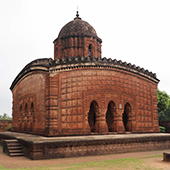These temples were built by the kings of the Malla dynasty in the 16th and 17th centuries. Madan Mohan temple was built by King Durjan Singha Deva in 1694 CE. Malla dynasty was Vaishnav, perhaps that explains the name Bishnupur. This region is also called Mallabhum. Bishnupur is in Bankura district and well connected with Kolkata by trains, buses and private vehicles too. The direct route is about 142km in terms of distance and takes about four hours. One can also take the Durgapur expressway which is a longer route but takes about three and half hours. More comfortable to drive and more expensive since it is a toll road. The first thing one notices about the Madanmohan temple is the Dochala styled gateway with a curved roof and the temple pinnacle standing tall in the backdrop. There is Chandi-mandap and another brick structure with the prototype curved roofs. Red terracotta bricks give a very attractive colour as well as a unique texture to the whole structure and give it a unique form identity. Madanmohan is a form of Bhagwan Vishnu and Vaishnava priests regularly perform puja here. This temple is in the ‘Ek Ratna’ style which means there is just one pinnacle.
While the overall structural form is very attractive, the real beauty of this temple lies in the delicate, communicative terracotta carvings that bring alive stories from Ramayana, Mahabharata and Puranas. Since Lord Krishna is the main deity of the temple, many stories revolve around the life story of Krishna. Apart from the bass-reliefs and sculptures with stories, we can also see various floral and decorative patterns carved. Some are free-flowing and some geometric. These temples have arches with a unique form, these arches interact with various lines around them and patterns created by crisscrossed terracotta. Arches and columns give a dynamic feel to the temples through a play of light and shadows.

























